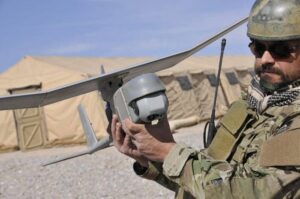AeroVironment, Inc. has received a $15,813,406 firm fixed-price authorization to perform on May 22, 2012 from the United States Army as the initial portion of a contract action with a total projected value of $65,889,191. The order includes RQ-11B Raven systems, new miniature gimbaled payloads and initial spares packages, and is funded from the Army’s fiscal 2012 procurement budget. Delivery of systems, spares and payloads is scheduled for completion by April 30, 2013.
AeroVironment unveiled its Mantis™ line of miniature gimbaled sensor payloads on April 1, 2012 at the Army Aviation Association of America symposium in Nashville, Tenn. Weighing 450 grams, the ruggedized, multi-axis Mantis i23 houses an electro-optical and infrared thermal video sensor in addition to a laser illuminator. The single payload replaces two separate sensor payloads on the Raven air vehicle, delivering daytime and nighttime capabilities from a single package.
“The U.S. Army has more than 1,700 Raven systems in its inventory with an ultimate goal of more than 2,300 systems,” said Roy Minson, AeroVironment senior vice president and general manager, Unmanned Aircraft Systems. “Since winning the Army’s small unmanned aircraft system competition in 2005 we have focused on delivering highly reliable, highly capable Raven systems and on continuously enhancing their capabilities. The new miniature gimbaled payload is the latest example of cost-effective improvements that will benefit soldiers directly through enhanced situational awareness.”
The RQ-11B Raven unmanned aircraft system is a 4.2-pound, backpackable, hand-launched sensor platform that provides day and night, real-time video imagery wirelessly to a portable ground control station for “over the hill” and “around the corner” reconnaissance, surveillance and target acquisition in support of tactical units. U.S. armed forces use Raven systems extensively for missions such as base security, route reconnaissance, mission planning and force protection. Each Raven system typically consists of three aircraft, two ground control stations and spares.



















